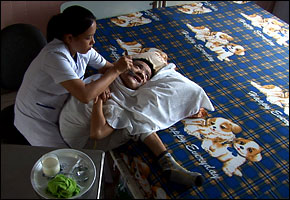DA NANG, Vietnam U.S.
Van, 5, spends her days at home, playing by herself on the concrete floor because local school officials say her appearance frightens other children. She has an oversize head and a severely deformed mouth, and her upper body is covered in a rash so severe her skin appears to have been boiled. According to Vietnamese medical authorities, she is part of a new generation of Agent Orange victims, forever scarred by the U.S.-made herbicide containing dioxin, one of the world's most toxic pollutants.
the concrete floor because local school officials say her appearance frightens other children. She has an oversize head and a severely deformed mouth, and her upper body is covered in a rash so severe her skin appears to have been boiled. According to Vietnamese medical authorities, she is part of a new generation of Agent Orange victims, forever scarred by the U.S.-made herbicide containing dioxin, one of the world's most toxic pollutants.
For decades, theUnited States Vietnam U.S.
Though neither Nguyen nor her husband was exposed to the Agent Orange sprayed byU.S.
Vietnamese andU.S.
Now theUnited States U.S. Vietnam
"The need to deal with environmental cleanup is increasingly clear, and we're moving forward from talking to taking concrete actions to respond to the issue," the official said, speaking on condition of anonymity because the project has not yet been publicly announced.
The more politically sensitive issues of responsibility and direct compensation for victims remain unresolved. Although medical authorities here estimate that there are more than 4 million suspected dioxin victims in
there are more than 4 million suspected dioxin victims in Vietnam United States
Still, with a much-changedVietnam Asia 's most dynamic economies -- the French luxury house Louis Vuitton has opened a branch in Hanoi Vietnam
Van, 5, spends her days at home, playing by herself on
 the concrete floor because local school officials say her appearance frightens other children. She has an oversize head and a severely deformed mouth, and her upper body is covered in a rash so severe her skin appears to have been boiled. According to Vietnamese medical authorities, she is part of a new generation of Agent Orange victims, forever scarred by the U.S.-made herbicide containing dioxin, one of the world's most toxic pollutants.
the concrete floor because local school officials say her appearance frightens other children. She has an oversize head and a severely deformed mouth, and her upper body is covered in a rash so severe her skin appears to have been boiled. According to Vietnamese medical authorities, she is part of a new generation of Agent Orange victims, forever scarred by the U.S.-made herbicide containing dioxin, one of the world's most toxic pollutants.For decades, the
Though neither Nguyen nor her husband was exposed to the Agent Orange sprayed by
Vietnamese and
Now the
"The need to deal with environmental cleanup is increasingly clear, and we're moving forward from talking to taking concrete actions to respond to the issue," the official said, speaking on condition of anonymity because the project has not yet been publicly announced.
The more politically sensitive issues of responsibility and direct compensation for victims remain unresolved. Although medical authorities here estimate that
 there are more than 4 million suspected dioxin victims in
there are more than 4 million suspected dioxin victims in Still, with a much-changed
Articolo tratto da Washingtonpost.com





Nessun commento:
Posta un commento